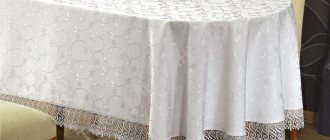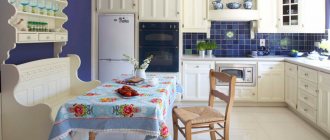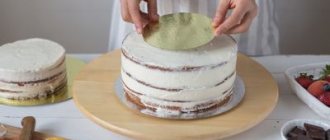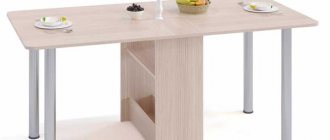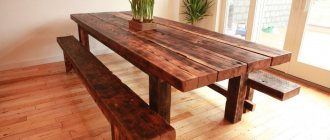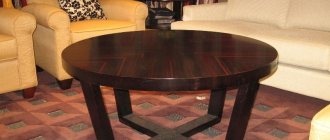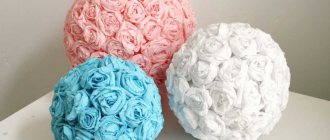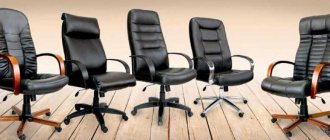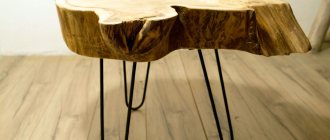Types of countertops and their main defects
The working surface can be made of different materials. Each of them is susceptible to the appearance of different defects that will have to be dealt with:
- Natural stone is the most popular and durable material, least susceptible to wear and tear, and has a long service life. A kitchen table top made of natural granite is not afraid of either temperature or mechanical influence, and is also not susceptible to damage due to chemicals.
- Acrylic. This type of artificial material looks very attractive. But it has its drawbacks. Acrylic is resistant to scratches and cuts, while other artificial stone kitchen countertops, such as colored concrete, are more durable.
- Quartz agglomerate. Resistant to all types of impact, as durable as natural granite. But over time it loses its aesthetics.
- Casting stone is a type of thin-layer polymer that has a base. The material cannot withstand grinding with force, so you need to be extremely careful when doing this.
- Plastic is the most budget-friendly option for decorating a kitchen work surface, which explains its low performance characteristics. When cutting without using special boards, it wears out quickly.
- Tree. The tabletop uses material treated with impregnations and varnishes. Since the top polish can wear off over time, you need to think ahead about how to refinish your wood countertop.
Recommendations for selection
To choose a truly suitable tablecloth for the kitchen, you need to take into account a number of factors: style, material texture, color and much more.
- Casual or festive. The purpose is the most important issue. Decorating your kitchen table doesn't have to be a hassle. For daily use, it is recommended to choose a material that is sufficiently dense, non-slip and easy to clean. It is worth paying attention to the comfort of people sitting at the table - the length of the hanging edge is permissible no more than 20 cm. For festive table setting, you can choose a thinner and more “capricious” material, because you will not have to use it so often. Edges of about 30 cm and themed colors are acceptable.
- Form. Traditionally, the tablecloth is matched to the shape of the table, but you can experiment by playing with contrasts. A square table looks interesting with a round tablecloth; it smooths out the corners, allowing you to achieve an unusual drapery. The same goes for a rectangular table and an oval tablecloth. This rule also works if the table is round or oval.
- Size. There is a certain standard for the width of the overhanging edge. To avoid buying a tablecloth that is too large or too small for your kitchen, you need to measure the tabletop. For a round table, the diameter is measured, and for a square and rectangular table, the length and width are measured.
- Material. Many housewives refuse to use a tablecloth for the kitchen, fearing additional cleaning. Modern materials make it possible to forget about difficult-to-wash stains: textiles are impregnated with water-repellent compounds and spilled liquids are simply wiped off the surface. Tablecloths are also available made of PVC or with a vinyl or Teflon coating, which allows you to place hot dishes without the use of special stands. Of course, an oilcloth tablecloth will not last as long as a linen tablecloth, but it can be updated often, because the prices for this material are low.
- Colors. The design is selected based on the color scheme of the interior. A kitchen set in soothing colors and a laconic color scheme for the floor and walls require placing accents, which can be easily achieved with the help of a bright table design. The pattern may overlap with other elements of kitchen decor - curtains, potholders. When choosing an everyday tablecloth, it is better to prefer calm colors and patterns - bright colors quickly get boring, and contrasting patterns create the impression of disorder on the table.
Advice. A plain white, red or blue tablecloth will add solemnity to the table setting, and the dishes will look good against its background.
- Style. When decorating a kitchen table, you need to adhere to the style of the entire room. Fringe around the edges and monograms will emphasize the luxury of Baroque, while for a kitchen in the Provence style, a small print made in natural tones would be appropriate. The classic style involves cream colors without patterns. High-tech, just like minimalism, allows the use of coasters for dishes instead of the usual tablecloth. The double tablecloth looks very nice. This and many other ideas can be found in the photo in the gallery.
The variety of tablecloth styles for the kitchen allows you to transform any interior. Table decoration, harmoniously matched to the setting, taking into account all its features, will give a warm and cozy atmosphere to a family dinner or friendly tea party.
Renewal by polishing and grinding
The simplest and most optimal method of updating a working surface is polishing and grinding. In this way, you can restore kitchen countertops made of artificial stone or other similar material. When updating the surface of cast stone, you need to be extremely careful, since this material can only withstand 2-3 such updates. This is due to the fact that the stone itself is applied in too thin a layer to the base.
The following tools and materials are needed for work:
- Sander;
- polishing machine;
- special polishing paste.
There can be one tool for grinding and polishing (grinder), but with different attachments. In the first case it is abrasive P120, in the second - up to P1500.
The following steps need to be performed:
- Before updating the kitchen countertop with your own hands, you need to level the top layer with a grinding machine. During this, water must be constantly added to the surface to prevent the stone from heating up and deteriorating.
- Using polishing attachments (first with a coarse abrasive, gradually reducing it) to make the surface of the tabletop matte. The circles need to be constantly wetted. After this, you can use a special paste if you want to have a glossy countertop in the kitchen.
How to update a tabletop with film?
Pasting is considered a radical renovation method, as it allows you to radically change the appearance of the countertop. For this, thick vinyl film on a self-adhesive base or photo wallpaper is used. If you don’t know how to update your kitchen countertops with your own hands, you can follow the standard scheme:
- Degrease the surface and then sand it with a sanding machine. Inspect carefully. If there are chips or potholes, they must first be filled with repair putty, and then the described steps must be followed.
- Now you can stick the film on the tabletop. In this case, it is important to fix one side as well as possible, which will prevent distortions and movements of the canvas during rolling. You can simplify the gluing process by using a plastic or rubber spatula, which should be used to expel bubbles and smooth out the coating.
The service life of such a film is no more than 4 years, so the countertop will have to be updated more often. But her appearance will not bother you.
Painting using a stencil
This method of updating a kitchen countertop with your own hands can be considered one of the most original and creative. In this way, even the most risky fantasies and wishes are realized. Another advantage can be considered low financial costs. The update itself is performed in the following sequence:
- The first step is to choose a design for the stencil. Ideas can be found on the Internet and then printed on paper.
- Now you need to transfer the design onto the stencil material. It can be thick cardboard or thin plastic. Choose a material so that you can cut the template with scissors.
- Prepare brushes of the required size, foam sponge and acrylic paints.
- Wash the countertop surface thoroughly and degrease.
- Now you need to cover it with the main color, which will be the background. You can proceed to the next stage only after this layer has dried.
- Using the prepared stencil and sponge, apply the selected design. The paint layer should be thin. This will prevent paint from flowing under the stencil and making the design blurry. If there is any doubt that you will be able to apply the pattern carefully with a sponge, you can do it with a brush.
If desired, this method can be safely combined with decoupage, but it is not recommended to do this to update the working surface.
How to choose the right color for a tablecloth
As a rule, a tablecloth should perform not only a practical function, but also a decorative one. That is why it is important to choose the right color for it. It should be combined not only with the overall color scheme of your kitchen, but also with the dishes that will be placed on it. It is best to choose some plain tablecloths for dishes with patterns, and vice versa - bright colored tablecloths for plain dishes.
Read: Fighting allergens in the house
Don't forget about the wonderful way - the game of contrasts. You can use two tablecloths of different sizes that are opposite on the color wheel. You can also make your tablecloth a bright accent in your kitchen.
If you are afraid to choose the right color for the tablecloth, choose one color that will be the main color in the curtains, tablecloths, chair covers, napkins, and potholders. Combinations of plain and multi-colored fabrics will look great.
How to update an old kitchen countertop with paint and glass?
This type of countertop renovation is suitable for all worktop materials that must first be prepared. There are two ways:
- putty;
- grinding.
You can use any paint for painting, but the most suitable is:
- acrylic paint;
- alkyd enamel;
- water-based paint.
Before applying a layer of paint (there should be at least two, or preferably three, with each subsequent layer applied only after the previous one has dried), the surface must be degreased.
You can increase the service life of the tabletop by placing tempered glass on top. This will prevent damage to the painted coating and paint chips from getting into food. By the way, tempered glass can also be used in other renovation methods, for example, pasting, painting.
Decoupage under glass
You must first select a suitable pattern. Ready-made decoupage pictures are sold in specialized stores, but there is a more economical way. Drawings can be cut out from napkins, magazines, newspapers, or you can print a composition selected on the Internet. All work is carried out in several stages:
- First you need to clean and then degrease the surface.
- Dilute PVA with water in equal proportions. You can also take special glue for decoupage, but as a rule, it is sold in small quantities, so before updating the countertop in the kitchen with your own hands, you will need to make careful calculations. Moisten the prepared picture in this mixture.
- Glue the soaked image to the surface of the tabletop, smooth it, removing all bubbles.
- Leave the countertop to dry completely.
- Now the surface needs to be covered with several layers of varnish. There should be at least three, but ideally it is better to make four. In this case, each subsequent layer can be applied only after the previous one has completely dried.
You can increase the service life of such a countertop by using tempered glass. In this case, decoupage can also be used to update the work area. The fact is that such a surface is afraid of exposure to aggressive detergents, high humidity and temperature. And tempered glass prevents damage.
Covering with decorative tiles
This method is suitable for updating products made from any materials. And this is also how the restoration of tabletops made of wood, plastic, chipboard or fiberboard is carried out. You can choose regular ceramic tiles or mosaics (using the second option has more possibilities). When choosing a color scheme, you need to take into account the color of the apron, which is located directly above the countertop.
You can make your design more original by using tiles of different sizes and shapes.
Before updating the kitchen countertop with your own hands, you need to prepare the following materials and tools:
- directly tile according to the chosen design;
- glue;
- grout.
After preparing the necessary tools and materials, you can start working:
- Clean the surface, degrease and dry.
- Apply glue to the countertop and directly to the ceramics.
- Place the tiles on the surface.
- Leave until completely dry.
- Now you can sand the seams. Apply the grout with a spatula, and then remove the remaining residue with a damp cloth.
Choosing the shape of the tablecloth
So, what shape should you choose for a tablecloth? Everything here is extremely simple - the shape of the tablecloth depends on the shape of the tabletop. If you have a square table, then a tablecloth of a similar shape will suit you, and the same is true with a rectangular table.
But the round table gives more freedom of choice. You can purchase both a round and square tablecloth. Combinations of two tablecloths look especially beautiful on round tables. You can place a round one on the bottom and a smaller square one on top. It will be great if the two tablecloths have contrasting colors.
Read Kitchen in biotech style
For an oval table, you can choose an oval and rectangular tablecloth. By the way, a tablecloth cover can be an excellent option for any table. It is made to order. Well, if you like to sew yourself, then you can easily try to sew it yourself. To do this, you need to cut a base from fabric to the size of the tabletop, and sew a skirt to it. For rectangular and square tables, a straight skirt with pintucks at the corners is suitable. But on oval and round tabletops, hanging edges with folds look incredibly beautiful.
Restoration with concrete
Not all renovation methods are suitable for worn concrete countertops due to the characteristics of the material itself. But concrete can be safely used to restore a working surface made of stone, both artificial and natural. The following materials are needed for work:
- mixture for finishing concrete screed;
- sealant (preferably acrylic);
- concrete varnish;
- volumetric container for preparing the solution;
- 2 spatulas of different sizes (20 mm and 10 mm);
- coarse sandpaper;
- industrial mixer (can be replaced with a drill with a special attachment);
- grinder with grinding disc.
The amount of mixture for the concrete screed depends on the size of the countertop itself. This information can be read directly on the packaging. The standard consumption is 1.2-1.5 kg per 1 m2 of surface with a layer thickness of 1 mm.
The restoration process itself is as follows:
- Before applying concrete, you need to carefully prepare the surface. It needs to be cleaned of dirt; it is recommended to pay special attention to leftover food and fat. You can use dishwashing detergents for this. If, during inspection, residues of silicone sealant were found, they must be removed, since concrete has low adhesion to this material (that’s why you need to use acrylic sealant).
- After all contaminants have been removed, the surface must be treated with sandpaper of different calibers (25-N and 20-N). This procedure will increase the adhesion of concrete to the old surface. That's why you don't need to think about how to remove a scratch on a countertop.
- Now the surface needs to be washed and then left to dry.
- After this, you can begin preparing the solution. How exactly to do this is indicated on the packaging, as there may be some nuances. In most cases, the mixture must be diluted with water in a 2:1 ratio. It is better to add water gradually so that the solution is not too thin or thick. Ideally, the consistency should be like sour cream. It is recommended to first prepare a small portion in order to be sure of the correct proportions later on.
- The prepared solution must be applied to the surface of the countertop with a spatula. Distribute the composition over the countertop with smooth and slow movements. This will reduce the risk of bubbles. To restore the tabletop, a concrete layer of 1-2 mm is sufficient (this depends directly on the material of the product and the existing problems). But to improve performance characteristics, it is recommended to make several such layers.
- The next step is sanding. You can start working on it only after the layer has completely dried. This will take at least 24 hours. For sanding you need to use coarse sandpaper or a grinder with a sanding disc. When covering with concrete in several layers, the procedure must be repeated for each layer. The latter should also be treated with fine-grained sandpaper.
- The restoration must be completed by coating with acrylic sealant (it must be applied with a brush). And you can also cover the surface with a layer of varnish if you want to get a glossy surface; by the way, you can use it to change the color of the countertop. Afterwards, you need to sand the top again with fine-caliber sandpaper.
Replacing the countertop
In some cases, restoring a countertop made of artificial stone or other material is impossible for various reasons. Then it is much easier and cheaper to buy and replace the surface than to restore it. You can make the replacement yourself. You will need the following tools and materials:
- drill with a set of different drills;
- electric jigsaw;
- files;
- fine-grained sandpaper;
- sealant;
- putty knife;
- pencil;
- pattern;
- roulette;
- square
You can replace the tabletop by proceeding as follows:
- Turn off water and other communications, then remove the sink.
- Remove the tabletop. This must be done extremely carefully, while preserving the elements that secured the surface to the table, for example, screws, corners and other fasteners.
- Clean the area where the new work surface will be installed in the future. Particular attention should be paid to the joints.
- If the new countertop for the kitchen table was purchased without holes for the sink and stove, then at this stage they need to be made. Although it is better to entrust this work to specialists, especially if it is a stone or glass product.
- The prepared surface should be installed in place. Before final fastening, you need to make sure that it lies strictly horizontally.
- Finish the installation of the tabletop using special corners. They will not only give the structure a complete appearance, but also increase its performance characteristics.
How to cover the dining table in the kitchen?
Excellent table settings are not always enough to give the dining table an attractive appearance. Textiles in the form of napkins and tablecloths, as well as plates and runners will help add a festive touch to the dining table.
Tablecloths for the table When choosing a tablecloth for the dining table, special attention should be paid to the following indicators:
Tablecloth shape. The ideal option is when it completely matches the shape of the piece of furniture. It is recommended to place a square or round tablecloth on a round table, only a square one on a square table, an oval tablecloth on an oval table, and, in extreme cases, a rectangular tablecloth, and only a rectangular one on a rectangular table.
Size. You should measure the length and width of the tabletop, or diameters. After this, the length of the overhang is added to the resulting value. The overhang should be between 20-40 centimeters long on each side.
Shades must match the interior. The color of the tablecloth can harmonize not only with the finishing materials, but also with the decorative elements in the room.
Runners An interesting solution for decorating a dining table can be tablecloth runners or runners. It is a rather narrow strip of textile and is placed the entire length of the dining table. Very often there may be an overhang. As a rule, the main first courses, a bowl of fruit and a bouquet of flowers are placed on it. You can lay the runner across the tablecloth, as well as diagonally or in the middle. An original solution would be a runner and a tablecloth in contrasting colors.
Placemats and napkins For the runner, as well as for the tablecloth, the napkin is considered to be an integral element of the decor of a festive or just a dinner table. They, as a rule, come as components for the tablecloth, mostly in the same color scheme, but occasionally the colors of the tablecloth and napkins can be contrasting. Additional chic can be given to a piece of dining furniture by original folded napkins, which at the same time will also be a certain decoration of it.
Often, for table setting, rectangular or square napkins are used, which are made from natural materials: vegetable silk, cotton and linen. If the table is set only for an ordinary family circle, then it is not necessary to cover it with an elaborate tablecloth. In this situation, you can freely get by with just napkins placed under the plates of each family member.
Under plates have also gained great popularity in the modern world. They are often used as a place mat, located under cutlery and under plates. Subplates come in several varieties. They may differ in shape and size, color and production material: rattan, plastic, bamboo or paper.
As you can see, there are many ways to beautifully decorate a holiday table. It’s worth showing your imagination and decorating the dining table according to your own motif. It is not necessary to use the services of designers in this situation.
(Visited 2 times, 1 visits today)
Tabletop care
Proper care will help increase the service life of your countertop. There are five golden rules, the observance of which will allow you to update your work surface much less frequently:
- Use a cutting board to cut food, even if it's just one piece of bread.
- Do not place hot dishes on the countertop, even if the work surface is made of stone.
- Do not use abrasive cleaners to clean the surface. It is better to replace the latter with more gentle ones.
- Try to avoid hitting the surface, so it’s better to beat the meat in a different place.
- Do not leave the tabletop wet; it must be wiped dry with a cloth after each wash.
Despite the apparent simplicity of all update methods, in some cases it is better to trust the professionals. This is due to the need to have certain skills, tools and experience.
Choosing fabric for a tablecloth
Tablecloths are made from a wide variety of materials. Therefore, it is difficult for an ordinary buyer who does not particularly understand fabrics to make the right choice. Let's take a look at the most popular types of fabrics together.
One of the most popular materials is linen. It has been used to make tablecloths since ancient times. Outwardly, it looks expensive, but at the same time it has a very capricious character - it shrinks a lot after washing, wrinkles very easily, but irons extremely poorly. A linen tablecloth is the best textile option for a festive table.
Read Lights above the work surface
Natural jacquard fabric is also very popular. It can give the table a luxurious look. But do not forget that she needs decent care.
Cotton is considered a true classic. It is easy to iron, but at the same time it shrinks significantly when washed. Therefore, it is unlikely to be suitable for daily use, but for special occasions it is an ideal option.
There are also mixed fabrics. They contain two types of fibers: natural and synthetic. They are incredibly practical: easy to wash, do not shrink and iron well. In addition, their appearance always remains at its best.
Incredibly practical tablecloths made of polyester. They are easy to care for, do not wrinkle, and do not need ironing. And any stains can be easily removed from the surface without much effort.
PVC tablecloths are quite suitable for everyday use. They can be either woven or non-woven. Of course, they are not as soft as fabric tablecloths, but they are incredibly practical. After all, they don't need to be washed. All you need to do is wipe this tablecloth with a damp sponge as needed.
Recently, Teflon coating on tablecloths has become popular. With this type of tablecloth, you may be afraid to put a hot pan on the table. In addition, it will not absorb or allow moisture to pass through.

